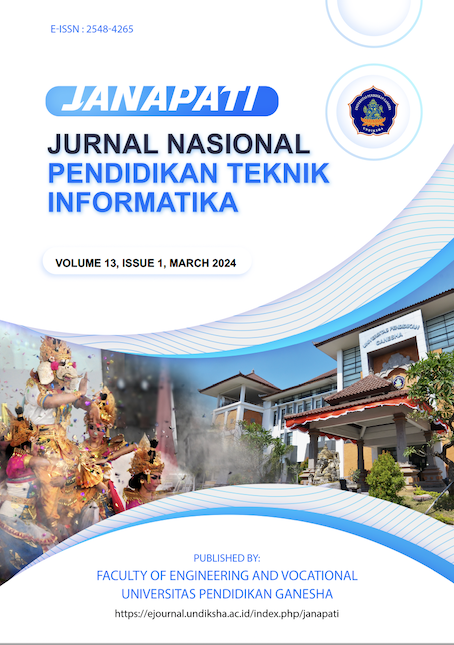Development of Virtual Reality for Optical Fiber Splicing Simulation
DOI:
https://doi.org/10.23887/janapati.v13i1.65358Keywords:
Virtual Reality, Simulation, Optical Fiber SplicingAbstract
This study aims to determine the design and evaluation of content and media experts in the development of Virtual Reality for Optical Fiber Splicing Simulation. The research method used is Research & Development with the Multimedia Development Life Cycle (MDLC) model which consists of concept, design, material collecting, assembly, testing, and distribution stages. This Virtual Reality development uses the Unity application in making applications with the Oculus Quest 2 device. The data collection process begins with interviews with educators about the learning that takes place, and the difficulties experienced. At the testing stage, Blackbox Test, Content Expert Test: 1.00 Validity Coefficient, and Media Expert Test: 1.00 Validity Coefficient. Virtual Reality for Fiber Optic Splicing Simulation offers simulation before implementing splicing in real. By taking characteristics of life such as laboratories, educators, and fiber optic practicum tools. Virtual reality can provide situations and conditions for students to practice Optical Fiber Splicing by entering a virtual laboratory in cyberspace. The learning experience in Virtual Reality that provides a sense of immersion in a virtual environment using Full Hand Interaction that applies the Hand Tracking function in Oculus Quest 2. Based on the overall test, the development of Virtual Reality for Optical Fiber Splicing Simulation is feasible to use and distribute to target students.
References
R. Tauhid, “Dasar-Dasar Teori Pembelajaran,” J. Pendas Pendidik. Dasar, vol. 1, no. 2, 2020.
D. Gorman, S. Hoermann, R. W. Lindeman, and B. Shahri, “Using Virtual Reality to Enhance Food Technology Education,” Int. J. Technol. Des. Educ., vol. 32, no. 3, 2022, doi: 10.1007/s10798-021-09669-3.
Trianto, “Model Pembelajaran Terpadu dalam Teori dan Praktek,” Jakarta, Prestasi Pustaka, 2007.
J. Alpenberg and D. P. Scarbrough, “Practice theory in a collaborative context,” J. Bus. Res., vol. 123, 2021, doi: 10.1016/j.jbusres.2020.09.046.
C. Kustandi and I. Lestari, “VIRTUAL REALITY USE IN ONLINE LEARNING,” Artic. Int. J. Eng. Technol., 2019.
I. Arkadiantika, W. Ramansyah, M. A. Effindi, and P. Dellia, “PENGEMBANGAN MEDIA PEMBELAJARAN VIRTUAL REALITY PADA MATERI PENGENALAN TERMINATION DAN SPLICING FIBER OPTIC,” J. Dimens. Pendidik. dan Pembelajaran, vol. 8, no. 1, 2020, doi: 10.24269/dpp.v0i0.2298.
Y. Liu, T. Liu, and Q. Ma, “Immersive Virtual Reality Teaching in Colleges and Universities Based on Vision Sensors,” Wirel. Commun. Mob. Comput., vol. 2022, 2022, doi: 10.1155/2022/5790491.
G. Ryan et al., “Virtual reality in midwifery education: A mixed methods study to assess learning and understanding,” Nurse Educ. Today, vol. 119, no. June 2021, p. 105573, 2022, doi: 10.1016/j.nedt.2022.105573.
D. R. Dela Cruz and D. M. M. Mendoza, “Design and Development of Virtual Laboratory: A Solution to the Problem of Laboratory Setup and Management of Pneumatic Courses in Bulacan State University College of Engineering,” 2018 IEEE Games, Entertain. Media Conf. GEM 2018, pp. 20–23, 2018, doi: 10.1109/GEM.2018.8516467.
E. Stella, I. Agosti, N. Di Blas, M. Finazzi, P. L. Lanzi, and D. Loiacono, “A virtual reality classroom to teach and explore crystal solid state structures,” Multimed. Tools Appl., 2022, doi: 10.1007/s11042-022-13410-0.
R. Saputra, Subari, and S. Yahya, “Penerapan Teknologi Virtual Reality Pada Property Perumahan,” 2021.
C. Xiong, K. S. Cheung, D. S. Levy, and M. Allen, “The effect of virtual reality on the marketing of residential property,” Hous. Stud., 2022, doi: 10.1080/02673037.2022.2074971.
D. Checa and A. Bustillo, “A review of immersive virtual reality serious games to enhance learning and training,” Multimed. Tools Appl., vol. 79, no. 9–10, 2020, doi: 10.1007/s11042-019-08348-9.
A. Akbulut, C. Catal, and B. Yıldız, “On the effectiveness of virtual reality in the education of software engineering,” Comput. Appl. Eng. Educ., vol. 26, no. 4, pp. 918–927, 2018, doi: 10.1002/cae.21935.
R. Lamb, P. Antonenko, E. Etopio, and A. Seccia, “Comparison of virtual reality and hands on activities in science education via functional near infrared spectroscopy,” Comput. Educ., vol. 124, no. July 2017, pp. 14–26, 2018, doi: 10.1016/j.compedu.2018.05.014.
A. C. Luther, Authoring interactive multimedia. 1994.
R. J. Gregory, Psychological testing: History, principles and applications seventh edition. 2015.
S. Pandita and A. Stevenson Won, “Clinical applications of virtual reality in patient-centered care,” in Technology and Health, 2020.
A. Hambali, “SKKNI Instalasi Fiber Optik-2018-101,” ResearchGate, no. July, 2019.
Downloads
Published
How to Cite
Issue
Section
License
Copyright (c) 2024 Rahmat Gah Bahaduri, I Gede Partha Sindu, Dessy Seri Wahyuni

This work is licensed under a Creative Commons Attribution-ShareAlike 4.0 International License.
Authors who publish with Janapati agree to the following terms:- Authors retain copyright and grant the journal the right of first publication with the work simultaneously licensed under a Creative Commons Attribution License (CC BY-SA 4.0) that allows others to share the work with an acknowledgment of the work's authorship and initial publication in this journal
- Authors are able to enter into separate, additional contractual arrangements for the non-exclusive distribution of the journal's published version of the work (e.g., post it to an institutional repository or publish it in a book), with an acknowledgment of its initial publication in this journal.
- Authors are permitted and encouraged to post their work online (e.g., in institutional repositories or on their website) prior to and during the submission process, as it can lead to productive exchanges, as well as earlier and greater citation of published work. (See The Effect of Open Access)







